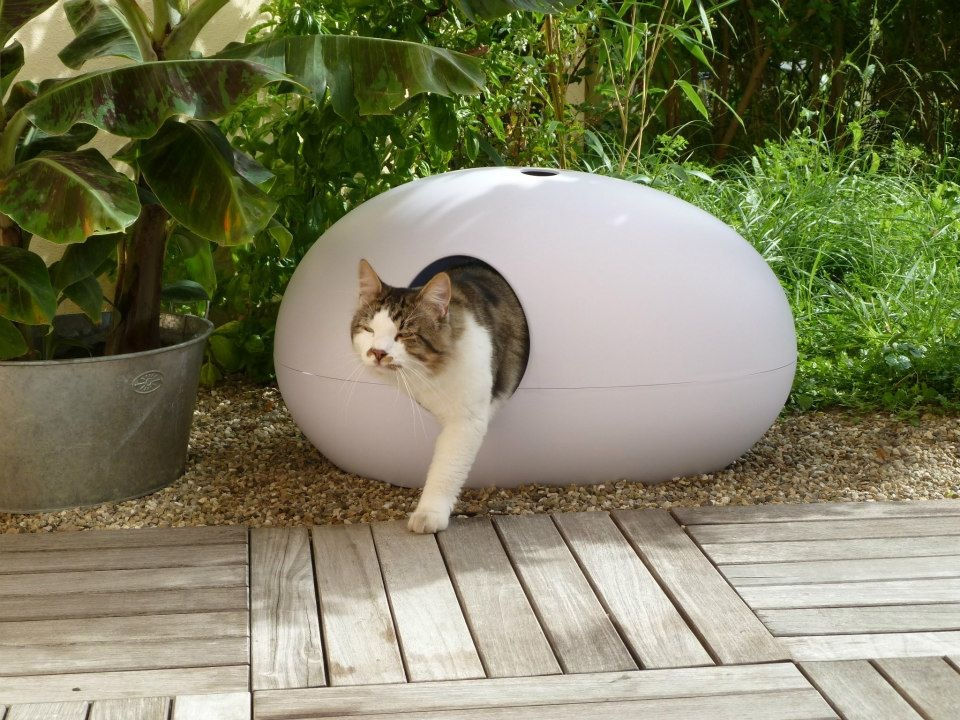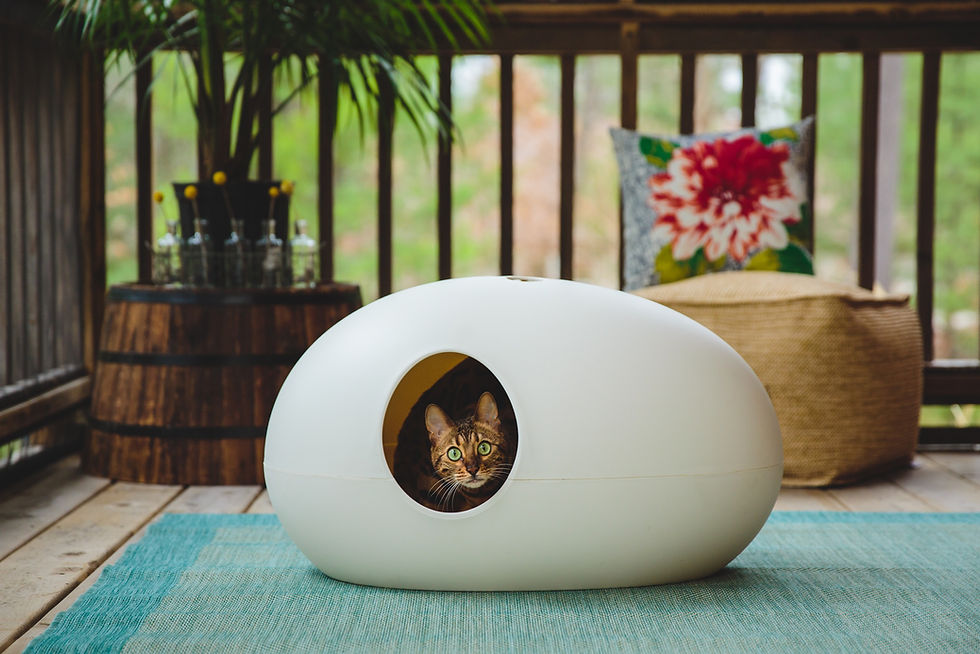Common Cat Behaviour Issues - House Soiling
- Kittyglitz

- Jul 9, 2020
- 7 min read
Updated: Jun 28, 2023
by Clare Hemington DipCAPBT
Cat Behaviourist & Founder of Award-Winning Honeysuckle Cat Toys

As a Cat Behaviourist I treat lots of different cat behaviours, but one that I see more frequently than others is house soiling.
If you’ve experienced this issue with your cat, you’ll know how upsetting it can be, from both a practical and emotional perspective.
In this article I’ll be looking at how, by creating the perfect indoor toileting facilities for your cat you can either manage or resolve existing house soiling issues or help prevent them happening in the first place.
What is house soiling?
House soiling is when your cat uses your sofa, duvet, carpet, or any other household surface as a toilet, in preference to his litter tray. The term applies to both urinating and/or defecating.
Why Do Cats House Soil?
The first step in addressing this problem is to understand why your cat is performing the behaviour in the first place. Here are the two most common reasons why cats house soil:
Medical issues
The existing litter tray setup doesn’t fulfill your cat’s requirements
Medical Issues
Whenever your cat’s elimination habits change, the first thing you should do is take him for a veterinary check-up. Your vet may want to take a sample of your cat’s urine to analyse. If a physical cause is found this will be treated by your vet.

Litter Tray Setup
If, however no physical cause for the behaviour is found, then it’s time to look at what’s going on in your cat’s environment that could be causing the behaviour. This means taking a good hard look at the litter tray set up, assuming there is one.
If you don’t have an indoor litter tray for your cat now is absolutely the time to get one, even if he has consistently toileted outdoors up until now. When your cat toilets outside he is in a very vulnerable position, quite literally. So, if a neighbouring cat decides to ambush him mid-flow, this is likely to put him off going to the loo outside for life. Under these circumstances, he will then find himself choosing an alternative site indoors that fulfils any of his personal criteria for a suitable toilet. A habit will then develop, and he will continue to return to the chosen indoor location or surface as a conditioned response. But before rushing out to your nearest pet superstore, do read the guidelines below because choosing and installing a litter tray is not as easy as you might think!
Cats are very finicky when it comes to their toilet facilities, and to make life even more difficult for us, each cat usually has his or her own individual preferences when it comes to the perfect litter tray set up.
For example the litter tray might be too small or covered with a hood; it might be in the wrong location; the litter might be too hard; your cat might perceive the tray to be too dirty or (believe it or not) too clean or there may not be enough trays for the number of cats in the household.
Let’s look at each of these in more detail.
Size of Tray
A litter tray should be large enough to allow your cat to turn around in the tray and manoeuvre himself into positions where he can comfortably urinate, defecate and rake the litter once he’s finished.
The ideal size for a cat litter tray is one and a half times the length of your cat from the base of his tail to the tip of his nose.
Type of Tray
In terms of the type of tray, some cats favour open trays from which they can continue to keep an eye on what’s going on in their immediate territory, whilst others prefer the privacy that a hooded litter tray affords them.

Where there is more than one cat in a household, I usually advise getting an open tray. The reason for this is that litter tray hoods can provide the perfect place for a cat to sit, ready to ambush his unsuspecting feline housemate when he exits the tray.
If you do decide to buy a hooded tray, In all instances I recommend removing the door so your cat can poke his head out if he chooses.
Tray Location
Where a tray is located is a key determining factor when it comes to whether your cat will want to use it. For example, a cat is unlikely to use his tray if it’s located next to his food bowl. Let’s face it, none of us want to eat our dinner whilst sitting right next to our toilet!
Litter trays located next to noisy washing machines or in busy areas such as hallways, can be similarly off-putting for cats as can trays located in front of patio doors. This is likely to make a cat feel just as vulnerable as if he were toileting in the big bad world outside. Instead, placing the tray in a discreet corner of a quiet room will give your cat a sense of safety and seclusion whilst eliminating, after all we humans like a bit of privacy when going to the loo, so maybe our cats do too!
Type of Litter
There are a vast array of different litters available today, but which should you buy? Given the choice cats would vote for sand, as anyone with a sandpit in their garden will no doubt testify.
The reason for this is that the ancestor of today’s domestic moggie was a desert dweller, so toileting in something sand-like is completely instinctive for them. Not only that, but your cat’s paw pads are extremely sensitive, and if the litter is too hard or uncomfortable, he’s likely to vote with his paws and avoid it.

So, choose a soft, fine litter that clumps such as Intersand Classic Unscented Cat litter or Almo Nature Natural 100% Biodegradable Clumping Cat litter.
Clumping cat litters enable you to remove all the urine particles in one go which prevents the build-up of odour. And speaking of odour, try to avoid scented litters. Whilst these might smell fragrant to us, to a cat’s nose they can be overpowering and unpleasant, especially in such a small space. Once you’ve chosen your litter, try to avoid using too much or too little in the tray. Around 4cm is usually adequate although you might want to increase this if more than one cat uses the tray.
Number of Trays
There is of course another reason why your cat might soil outside his litter tray, and this is if he has to share the tray with other cats. This is especially relevant where cats in the same household don’t get on. If you have just one litter tray, a cat with a more confident personality might block access to it in order to prevent his timid counterpart using it. So, having enough trays for the number of cats in your home is especially important, and these should be located as far from each other as possible, both upstairs and downstairs (where applicable). Some cats like to urinate and defecate in separate trays so even if you have just one cat, having two trays is a good idea.
Litter Tray Cleaning
Although not very pleasant, cleaning a litter tray is part and parcel of cat ownership and it’s important that it’s done effectively. After all, if you had to use a toilet that didn’t flush, you’d start considering your options. How often you clean a tray depends on how often its used and how many cats are using it. In a household with one or two cats I recommend removing urine clumps and other solids and topping the litter up twice daily. It’s normally appropriate to empty and wash trays weekly using hot water and mild washing up liquid only.
Avoid using scented deodorisers as part of your cleaning routine, as with scented litter, the smell of these can be off-putting for cats. Another undesirable addition to your litter tray, as far as your cat is concerned, are litter liners. If your cat gets his claws caught in these, this can create a negative association around using the tray.
Cleaning Soiled Areas
The way you clean the areas where your cat has soiled can play a part in determining whether your cat continues to soil there. If you can, wash the soiled surface in a washing machine or take it to the dry cleaners. Where this is not possible for example if your cat has urinated on a carpet, always use an enzymatic cleaner specifically made for removing cat urine and avoid any cleaners that contain ammonia. This is because cat urine contains ammonia, so cleaning it with an ammonia-based product will only serve to reinforce the site as an appropriate toilet.

You might be tempted to use remedies such as putting tin foil, citrus peel, or pepper on the soiled areas, but in my experience, cats simply ignore these and carry on performing the behaviour anyway.
What is effective, in addition to all the above measures, is to deny your cat access to those areas until he is back using his tray for every toilet trip. This might mean keeping doors to rooms closed or moving furniture over soiled sites.
Owner Response
How you react to your cat’s soiling behaviour can also have an influence on the behaviour. Whilst you might find it difficult not to vent your frustration, in doing so you can actually make things worse. Firstly, unless you do this whilst your cat is in the act of committing the crime, he won’t associate the behaviour with your reaction. Secondly, your change in mood and response to him is likely to create a level of stress in him that might just go to his bladder….
Conclusion
If your cat is soiling around your home, it can be a disheartening and frustrating problem. But you can attract your cat back to his litter tray by having the right size and type of tray, in the right quantity and in an acceptable location (for your cat) with the right litter and with an appropriate cleaning regime for both the tray and the soiled area. It may take trial and error to establish the optimum set up for your cat, but it will be worth it!









Comments